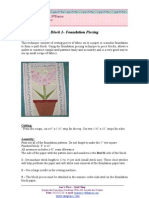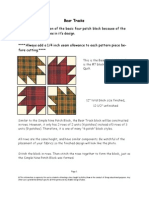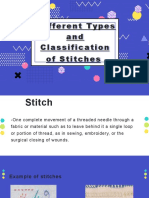Fish Baby Log Cabin Quilt Pattern
Fish Baby Log Cabin Quilt Pattern
Uploaded by
olivedaisychainCopyright:
Available Formats
Fish Baby Log Cabin Quilt Pattern
Fish Baby Log Cabin Quilt Pattern
Uploaded by
olivedaisychainCopyright
Available Formats
Share this document
Did you find this document useful?
Is this content inappropriate?
Copyright:
Available Formats
Fish Baby Log Cabin Quilt Pattern
Fish Baby Log Cabin Quilt Pattern
Uploaded by
olivedaisychainCopyright:
Available Formats
Fish Baby Log Cabin
!
!
!
Designed by: Malka Dubrawsky
Finished size: ~38” x 38”
The concept behind this design couldn’t be simpler; a single log
cabin block super-sized to create a top big enough for a baby
quilt. Combine this simple idea with a variety of contrasting and
similarly valued solids and you have a quilt that is direct, fresh,
and very modern, but also feels entirely functional.
Materials:
Fabric:
Fat eighths of 4 different cotton solids
Fat quarters of 8 different cotton solids
1/2 yard of 1 cotton solid
1/4 yard of cotton solid for binding
1 1/4 yard of coordinating cotton fabric for backing
Other Supplies:
Rotary cutter
Self-healing mat
Coordinating machine sewing thread
Quilter’s clear, acrylic ruler
Scissors
Pins
Iron
Quilt basting materials
Cotton batting measuring at least 45” x 45”
Coordinating machine or hand quilting thread
Hand sewing needle
Cutting the Quilt Top Fabric:
Note: Fabric measurements are listed for strips appearing from
the center out. Some strips may need to be pieced to make
length requirements. For instance my outermost strips were sewn
out of same width strips to make lengths needed.
Cut the following:
Center Square: 1 1/2" x 1 1/2"
4 strips measuring 1” x 2 1/2”
4 strips measuring 1 1/2" x 4 1/4”
4 strips measuring 1” x 5 1/4"
4 strips measuring 1” x 6 1/2"
4 strips measuring 2 1/2" x 10 1/2"
4 strips measuring 1 1/2" x 12 1/4"
4 strips measuring 1 1/4" x 13 1/4"
4 strips measuring 1 1/8” x 15”
4 strips measuring 1 1/4" x 16 1/2"
4 strips measuring 2 1/2" x 20 1/2"
4 strips measuring 1” x 21 1/2"
4 strips measuring 2 3/4" x 25 3/4"
4 strips measuring 1” x 26 1/4"
4 strips measuring 1 1/2” x 28 1/4"
4 strips measuring 2 1/4" x 31 1/2"
4 strips measuring 4 1/4" x 38 1/2”
Cutting the Remaining Fabric:
From cotton solid for binding, cut 1 1/2" strips
Making the Patchwork:
Note: All seam allowances are 1/4". Press seams to one side,
alternating sides where seams intersect.
1. Working with center square and 1, 1” x 2 1/2" strip, pin
strips to one side of center square, right sides together.
Note: Strip edge is longer than center square edge. After
sewing, strip will be trimmed to same length as center
square.
2. Sew together. Press seam. Trim as necessary.
3. Pin second strip to sewn pair, right sides together, so that
is perpendicular to sewn pair.
4. Sew together. Press seam. Trim as necessary.
5. Continue pinning, sewing, and pressing strips until all four
strips have been sewn to center square.
6. Working with next set of strips (1 1/2" x 4 1/4"), pin one
strip to sewn section, right sides together.
7. Sew together. Press seam trim as necessary.
8. Continue pinning, sewing, and pressing strips around sewn
section until all four 1 1/2" x 4 1/4" strips are attached.
9. Continue concentrically attaching differently sized strips,
sewing together strips if necessary to create required
length.
Finishing the Quilt:
1. Layer backing fabric, wrong side facing up, batting, and
Quilt top, right side facing up on flat surface.
2. Baste layers together using preferred method.
3. Hand or machine quilt as desired.
Note: I free motion machine quilted the sample starting
from the center and stitching in concentric swirls to the
outer edges.
4. Trim layers flush
5. Sew binding strips together using diagonal seams.
6. Attach binding to front of quilt.
7. Hand stitch binding to back side remembering to turn under
1/4' seam allowance as you stitch.
You might also like
- Horse PiemDocument8 pagesHorse PiemPazmandi-Fodor Judit92% (24)
- Batiki ArgyleDocument6 pagesBatiki ArgyleDebbie BaileyNo ratings yet
- Granny Rocks Jumper PatternDocument8 pagesGranny Rocks Jumper PatternIvete PintoNo ratings yet
- French Braid Quilt Pattern 2Document11 pagesFrench Braid Quilt Pattern 2ChuckNo ratings yet
- PQ Pincushion Threadcatcher TuteDocument5 pagesPQ Pincushion Threadcatcher TuteKaren Farley Whiteside100% (1)
- Trim-Free, Template-Free Whirligig Block TutorialDocument4 pagesTrim-Free, Template-Free Whirligig Block Tutorialteaginny100% (1)
- All MineDocument16 pagesAll MineAngela Walters50% (2)
- Double Knit Slipper SockDocument10 pagesDouble Knit Slipper SockJudith A HelmsNo ratings yet
- Time Flies Quilt in Eclectic Elements by Tim HoltzDocument23 pagesTime Flies Quilt in Eclectic Elements by Tim HoltzRizia SouzaNo ratings yet
- Kumari Leaves Quilt: 54 1/2" X 60 1/2" by Cheryl A. AdamDocument4 pagesKumari Leaves Quilt: 54 1/2" X 60 1/2" by Cheryl A. AdamNursen Civan YarıkanNo ratings yet
- Plaid-Ish Scrap Quilt Tutorial - Kitchen Table QuiltingDocument3 pagesPlaid-Ish Scrap Quilt Tutorial - Kitchen Table QuiltingUrsula RichterNo ratings yet
- Elna EF72 Sewing Machine Instruction ManualDocument108 pagesElna EF72 Sewing Machine Instruction ManualiliiexpugnansNo ratings yet
- Beautiful Baby Quilt in Maman Nursery Basics From Cloud9 OrganicDocument17 pagesBeautiful Baby Quilt in Maman Nursery Basics From Cloud9 OrganicRizia Souza100% (2)
- Spice Cake Quilt: by Scott HansenDocument7 pagesSpice Cake Quilt: by Scott HansenNursen Civan Yarıkan100% (2)
- Nine Patch Nirvana: 2006 Block of The Month Turn, Turn, TurnDocument2 pagesNine Patch Nirvana: 2006 Block of The Month Turn, Turn, TurnAndreas D.No ratings yet
- No Point Stars Free PatternDocument5 pagesNo Point Stars Free PatternanamachadoagudoNo ratings yet
- A Place in Our HeartsDocument4 pagesA Place in Our HeartsmosaNo ratings yet
- Bloco 1Document2 pagesBloco 1anaplace_vaNo ratings yet
- Manta Gatitos Quilt en PDFDocument3 pagesManta Gatitos Quilt en PDFM.d. PejrhardssonNo ratings yet
- Wednesday, 29 August 2007: Cathedral Window Quilt TutorialDocument21 pagesWednesday, 29 August 2007: Cathedral Window Quilt Tutorialfeisal100% (1)
- Featuring "ALHAMBRA" Collection: Finished Size: 61,5" X 61,5"Document2 pagesFeaturing "ALHAMBRA" Collection: Finished Size: 61,5" X 61,5"ErikaNo ratings yet
- Turkey Crazy Quilt Tutorials and ColorsDocument40 pagesTurkey Crazy Quilt Tutorials and ColorsAndreas D.0% (1)
- Calypso Swing: by Ellen MaxwellDocument4 pagesCalypso Swing: by Ellen MaxwellNursen Civan YarıkanNo ratings yet
- Lemonade: Amy GibsonDocument2 pagesLemonade: Amy GibsonJorge Antonio Díaz NambrardNo ratings yet
- Quilt City TrafficDocument5 pagesQuilt City TrafficMirela1607100% (1)
- Chicken Quilt Block TutorialDocument7 pagesChicken Quilt Block TutorialCreek LiteracyNo ratings yet
- Come Live With MWDocument12 pagesCome Live With MWJjffjj KojgffNo ratings yet
- FCC Vintage PicnicDocument6 pagesFCC Vintage PicnicSon Ereck100% (1)
- Free Piping and Chevron Stripe Bag TutorialDocument19 pagesFree Piping and Chevron Stripe Bag Tutorialmizquita100% (2)
- Jelly Belly: Short CutDocument5 pagesJelly Belly: Short CutKaro TB100% (1)
- Nancy Mahoney: Fabric Collection byDocument4 pagesNancy Mahoney: Fabric Collection byFaye WrayNo ratings yet
- Bear TracksDocument4 pagesBear Tracksshaw.kathy100% (2)
- A Cat Tale Quilt 2Document5 pagesA Cat Tale Quilt 2meethi_andrea100% (1)
- Project: Pillowcase With Checkerboard Band: Pattern 6Document2 pagesProject: Pillowcase With Checkerboard Band: Pattern 6Maria AlvarengaNo ratings yet
- BRC Quilt RaffleDocument1 pageBRC Quilt Raffleapi-401135460No ratings yet
- Project: A Mother's Blessing: American Patchwork & Quilting - Quilt Sampler - Quilts and MoreDocument5 pagesProject: A Mother's Blessing: American Patchwork & Quilting - Quilt Sampler - Quilts and MorePriscilla ArtesNo ratings yet
- Four Eyes QuiltDocument10 pagesFour Eyes QuiltManuela HebgenNo ratings yet
- Learn To Make A Quilt From Start To Finish: CraftsDocument5 pagesLearn To Make A Quilt From Start To Finish: CraftsStefaniaRosati100% (1)
- Book Cover FabricDocument4 pagesBook Cover FabricTrish Hanson100% (1)
- Enjoy The Ride Free QuiltDocument5 pagesEnjoy The Ride Free QuiltArt Gallery FabricsNo ratings yet
- Heart Block PDFDocument11 pagesHeart Block PDFJjffjj KojgffNo ratings yet
- BgboxDocument2 pagesBgboxmochadreamz200546700% (1)
- Quarter Log Cabin Mini QuiltDocument10 pagesQuarter Log Cabin Mini QuiltVitor RodriguesNo ratings yet
- Wrap Dress InstructionsDocument1 pageWrap Dress Instructionsioana2694No ratings yet
- Block Library - #2 Old Maid's PuzzleDocument2 pagesBlock Library - #2 Old Maid's PuzzleNeyana Zsuzsa ParditkaNo ratings yet
- MBS Marmalade Squares Two QuiltDocument11 pagesMBS Marmalade Squares Two QuiltRosalia Ferron Perez100% (3)
- Stitch A "Star-Struck" Quilt!: Quiltville Custom QuiltingDocument5 pagesStitch A "Star-Struck" Quilt!: Quiltville Custom QuiltingVanya WorleyNo ratings yet
- Plane Quilt Pattern 54 X 72 FINALDocument11 pagesPlane Quilt Pattern 54 X 72 FINALAnonymous HEkiyY3LpENo ratings yet
- Nine Patch Nirvana: 2006 Block of The Month Ask and AnswerDocument2 pagesNine Patch Nirvana: 2006 Block of The Month Ask and AnswerAndreas D.No ratings yet
- After The StormDocument6 pagesAfter The Stormapi-259194221No ratings yet
- Kaleidoscopic Kites Free Quilt PatternDocument7 pagesKaleidoscopic Kites Free Quilt PatternENo ratings yet
- Sweetcakes 1Document2 pagesSweetcakes 1Georgia Stewart50% (2)
- Sms Stacking Quilted BlocksDocument8 pagesSms Stacking Quilted BlocksgiovannagNo ratings yet
- YR BOM October 2010Document5 pagesYR BOM October 2010gogail91No ratings yet
- Disappearing Nine Patch InstructionsDocument1 pageDisappearing Nine Patch InstructionsajNo ratings yet
- VW Bus Quilt Pattern PDFDocument6 pagesVW Bus Quilt Pattern PDFJan MeissnerNo ratings yet
- Fat Quarter Cubes Quilt Pattern: Fabric RequirementsDocument2 pagesFat Quarter Cubes Quilt Pattern: Fabric RequirementsKendra Koehler100% (2)
- Chart Móc Trái Tim Ôm NhauDocument12 pagesChart Móc Trái Tim Ôm NhauHeir ĐàNo ratings yet
- 86 REVISED Crossed Shell Grannt Square PDFDocument1 page86 REVISED Crossed Shell Grannt Square PDFpooNo ratings yet
- Monmouth CapDocument4 pagesMonmouth Capc cNo ratings yet
- 9-Chinese Zodiac - MonkeyDocument5 pages9-Chinese Zodiac - MonkeyTere ChongNo ratings yet
- Heart Full of Joy Pude UsDocument8 pagesHeart Full of Joy Pude UsMelinda MunkaiNo ratings yet
- Different StichesDocument65 pagesDifferent StichesMarc Noel RegachoNo ratings yet
- Cute Crochet Cat With Heart Amigurumi PDF PatternDocument5 pagesCute Crochet Cat With Heart Amigurumi PDF PatternJustyna Janicka100% (6)
- Crochet Pattern of Plush Minion BackpackDocument24 pagesCrochet Pattern of Plush Minion BackpackMaria Elisa Balestrini100% (1)
- Cac0107 012197MDocument3 pagesCac0107 012197Mbiblebuild2double06No ratings yet
- Shapely Tank TopUpdateDocument3 pagesShapely Tank TopUpdatenguyenhongv8No ratings yet
- Amish Puzzle Ball Crochet Pattern: MaterialsDocument3 pagesAmish Puzzle Ball Crochet Pattern: MaterialsBellvania AshleyNo ratings yet
- Lily PDF Knitting CrochetDocument1 pageLily PDF Knitting CrochetHugo AlvarezNo ratings yet
- 1 4929494657525612830 PDFDocument11 pages1 4929494657525612830 PDFCARLETE CACANo ratings yet
- Free Knitting Pattern Lion Brand Lion Wool Felted Needle HolderDocument3 pagesFree Knitting Pattern Lion Brand Lion Wool Felted Needle HolderErika FerencziNo ratings yet
- Amigurumi Holiday Penguin in Lion Brand Vanna's Choice - Digital VersionDocument5 pagesAmigurumi Holiday Penguin in Lion Brand Vanna's Choice - Digital VersionjuanNo ratings yet
- Miniature Heart Amigurumi Crochet Pattern v1Document3 pagesMiniature Heart Amigurumi Crochet Pattern v1David Raul Estrada Aguirre100% (1)
- Harry Potter Granny BlanketDocument3 pagesHarry Potter Granny BlanketMasked Cover Queens100% (1)
- More Simple Lines Version 2Document6 pagesMore Simple Lines Version 2AndreaNo ratings yet
- Twisted Peppermint: Finished Size: Gauge: MaterialsDocument6 pagesTwisted Peppermint: Finished Size: Gauge: MaterialsCrochet Free100% (2)
- Baru Embroidery Process Mozambique 3 May 2012Document36 pagesBaru Embroidery Process Mozambique 3 May 2012Moekarto Moeliono (Annom)No ratings yet
- Dinosaurios Rosa CelesteDocument45 pagesDinosaurios Rosa CelesteMaria Eva Perez100% (1)
- Little One Doily USDocument2 pagesLittle One Doily USputmyemailhereNo ratings yet
- 1 CoralinesmallDocument7 pages1 Coralinesmallmidger midgeeNo ratings yet
- Lower Looper and KnifeDocument4 pagesLower Looper and KnifeTauqeer RazaNo ratings yet
- The Bryor Bunny HoodDocument6 pagesThe Bryor Bunny HoodMCarmenPardoNo ratings yet
- F117HoHPatternF040Updated p3Document2 pagesF117HoHPatternF040Updated p3nata westNo ratings yet
- ByHer Crochet BTSDocument44 pagesByHer Crochet BTSlizbeth vasquez100% (5)

























































































